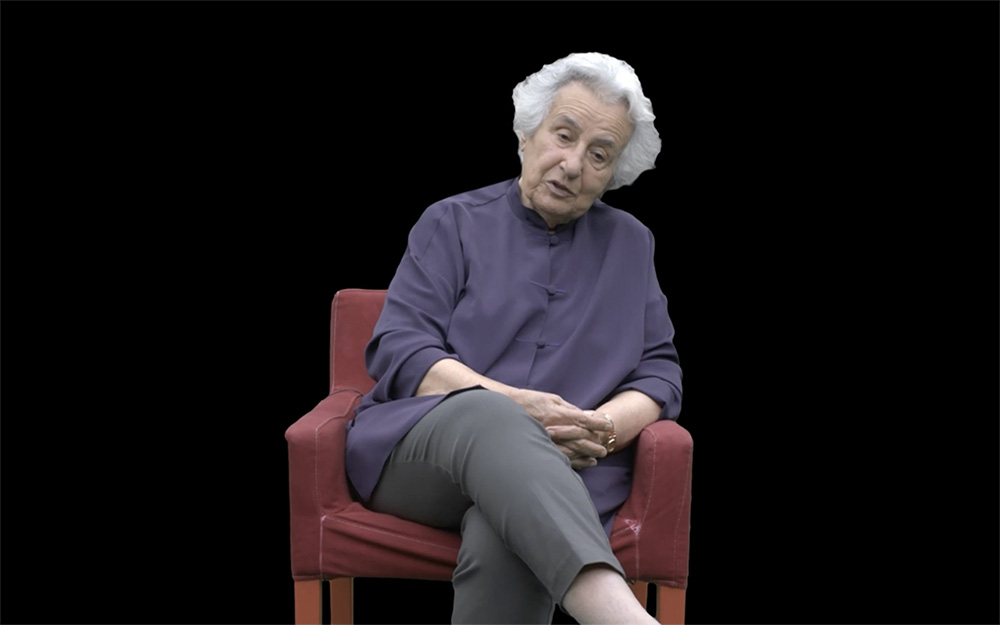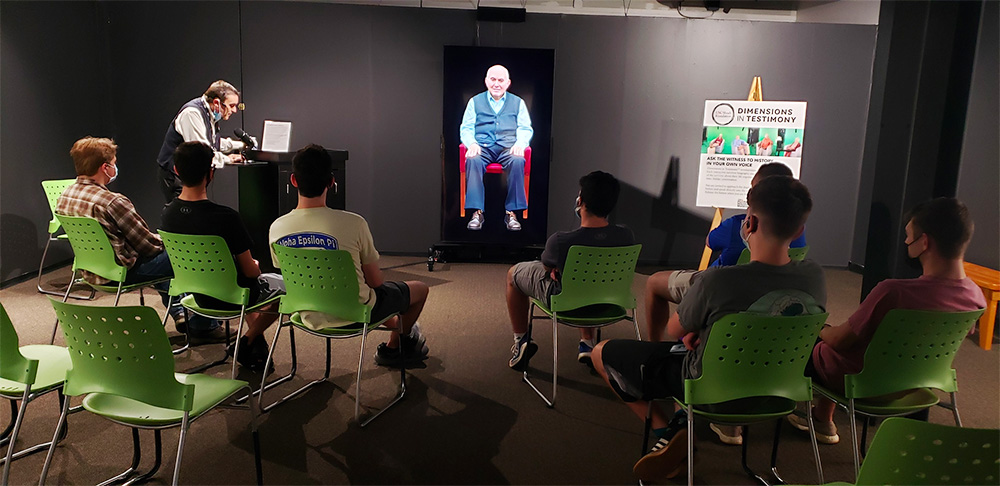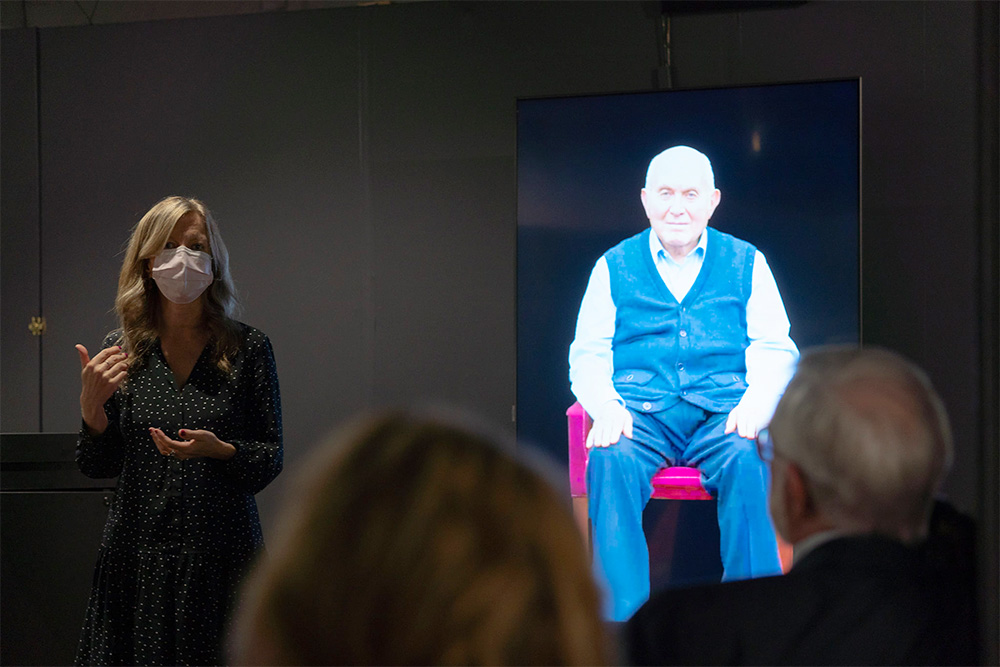Holocaust education is as massive an undertaking as it is an essential one. Though primarily concerned with the study of the Nazi genocide, any sound teaching of the Holocaust illustrates the dangers of prejudice and intolerance, and further, the need to combat the persisting specters of racism and discrimination today. Central to this educational endeavor is the survivor testimony — firsthand witness accounts that detail the very human cost of Nazi Germany’s state-sponsored mass murder.
These lived experiences form the core of USC Shoah Foundation’s Dimensions in Testimony project. While the Foundation, established by Steven Spielberg in 1994, has long been collecting the life stories of Holocaust survivors, the past few years have seen it integrate these recorded biographies with interactive technologies. The result, Dimensions in Testimony, is a series of pre-recorded interviews with Holocaust survivors that are programmed with AI tech including speech recognition and natural language processing such that audiences can converse with the subjects in real-time.

USC Shoah Foundation’s interactive biographies integrate advanced filming techniques, specialized display technologies and natural language processing, enabling audiences to converse with their subjects in real-time. Image: USC Shoah Foundation
Dimensions in Testimony is currently installed in a number of museums including the Los Angeles Museum of the Holocaust, the Dallas Holocaust and Human Rights Museum, and Illinois Holocaust Museum and Education Center, where visitors can ask questions of recorded survivors, who appear as video images on screens, and receive responses in direct and intimate encounters. “We know that one-on-one connection is where the impact is,” says Erin Blankenship, Interim Executive Director of the Florida Holocaust Museum (FHM), “where people can see themselves and make personal connections with their own lives.”
The FHM is one of the latest museums to host a Dimensions in Testimony exhibit. In April 2021, the institution recorded four survivor testimonies with USC Shoah Foundation, which were beta-launched in October in FHM’s temporary exhibition galleries. Post-beta, the plan is to build a standalone theater to permanently house Dimensions, where visitors can “still hear the stories [of survivors] in their own voices,” says Blankenship.

Dimensions in Testimony was beta-launched at the Florida Holocaust Museum in October; the museum has plans to construct a theater to house the installation. Image: Florida Holocaust Museum
Here, Blankenship expands on FHM’s partnership with USC Shoah Foundation and the centrality of digital technology in the museum’s mission.
How did the partnership with USC Shoah Foundation come about?
A few years ago, we partnered with them to digitize our collections. A portion of those have been added to their VHA [Visual History Archive] and I think about 26 of our testimonies are part of their IWitness platform, where students can use testimonies and other assets to create their own mini documentaries.
When did discussions about Dimensions begin?
Three years ago, we started the conversation, and we were looking at budgeting and how much it would cost us. But because of COVID, that process that we talked about a few years ago wasn’t possible. First of all, Holocaust survivors are a vulnerable age group and the former process was that the person had to go to a studio in California that they created just for this purpose. Because of COVID, USC Shoah Foundation came up with a new camera rig to be mobile-friendly and ours was the very first museum to use this rig. They also trusted us with doing the research and the script, which is basically questions that are specific to the Holocaust survivor and their story.

“You could literally spend hours and still hear new stuff, still be touched by something different,” says Erin Blankenship, Interim Executive Director of the FHM, of the Dimensions experience. Image: Florida Holocaust Museum
How is Dimensions installed within the FHM?
The version that’s here now is temporary because it is the beta test system, but we tried to create it to look like a permanent space as much as we could. It does include some exhibit text and photos about each of the four survivors, and of course, directions on what Dimensions is and a little insight about the technology for lay people. It’s on our second floor, which is normally our temporary exhibition galleries, and it’s kind of midway through a visitor’s experience here.
What’s been your own experience of Dimensions?
We worked with Pinchas Gutter, who was the first person ever recorded by USC Shoah Foundation for Dimensions and I already knew his story, but I don’t know everything. So even when it’s a question I’ve already asked Pinchas through Dimensions, you still get a little excited about what he’s going to say. Sometimes the same question might match up to two or three different answers, and you never know what you’re going to get. I think that that’s just what happens in a real conversation. You could literally spend hours and still hear new stuff, still be touched by something different. It’s incredible how emotive it is.
How have innovative technology like that in Dimensions and the FHM’s own digitization efforts enhanced its Holocaust education and storytelling?
It’s remarkable in the way it allows us to extend our reach that now we can certainly do things statewide, including in counties that are rural. That is something that’s extremely important to us because for one, we’re a partner of the Department of Education for the state of Florida to provide a Holocaust education. Plus, of course, we think it’s vital that everybody gets this information.
We have survivor testimonies, which we offer through Dimensions, but we also have our conversations with a survivor on Zoom or our recorded testimonies. And there’s digitization of our artifacts, photo collection, or documents, which helps to preserve them for future generations. That’s the mission of every museum — to collect, preserve, and provide access to this material — so it goes right to the heart of what we do.



